Polymeric Nanocomposites of Polyvinyl Alcohol Embedded with ZnO/CuO/Single-Walled Carbon Nanotubes: Optical and Radiation Shielding Investigations
Abstract
1. Introduction
2. Materials and Methods
3. Results and Discussion
3.1. Morphological Investigations
3.2. FT-IR Analysis
3.3. Optical Analysis
3.4. Radiation Shielding Investigations
4. Conclusions
Author Contributions
Funding
Institutional Review Board Statement
Data Availability Statement
Acknowledgments
Conflicts of Interest
References
- Soliman, T.S.; Abouhaswa, A.S. Synthesis and structural of Cd0.5Zn0.5F2O4 nanoparticles and its influence on the structure and optical properties of polyvinyl alcohol films. J. Mater. Sci. Mater. Electron. 2020, 31, 9666–9674. [Google Scholar] [CrossRef]
- Issa, S.A.M.; Zakaly, H.M.H.; Pyshkina, M.; Mostafa, M.Y.A.; Rashad, M.; Soliman, T.S. Structure, optical, and radiation shielding properties of PVA–BaTiO3 nanocomposite films: An experimental investigation. Radiat. Phys. Chem. 2021, 180, 109281. [Google Scholar] [CrossRef]
- Xu, F.; Yang, Y.; Liu, Y.; Yang, J.; Liao, Y.; Wang, X.; Shi, X.; Hu, J. Ferrite ceramic filled poly-dimethylsiloxane composite with enhanced magnetic-dielectric properties as substrate material for flexible electronics. Ceram. Int. 2021, 47, 18246–18251. [Google Scholar] [CrossRef]
- Abdeltwab, E.; Atta, A. Influence of ZnO nanoadditives on the structural characteristics and dielectric properties of PVA. Int. J. Mod. Phys. B 2021, 35, 2150310. [Google Scholar] [CrossRef]
- Badawi, A. Engineering the optical properties of PVA/PVP polymeric blend in situ using tin sulfide for optoelectronics. Appl. Phys. A 2020, 126, 335. [Google Scholar] [CrossRef]
- Badawi, A.; Alharthi, S.S. Controlling the optical and mechanical properties of polyvinyl alcohol using Ag2S semiconductor for environmentally friendly applications. Mater. Sci. Semicond. Process. 2020, 116, 105139. [Google Scholar] [CrossRef]
- Dhatarwal, P.; Sengwa, R.J. Investigation on the optical properties of (PVP/PVA)/Al2O3 nanocomposite films for green disposable optoelectronics. Phys. B Condens. Matter 2021, 613, 412989. [Google Scholar] [CrossRef]
- Atta, A.; Abdelhamied, M.M.; Abdelreheem, A.M.; Althubiti, N.A. Effects of polyaniline and silver nanoparticles on the structural characteristics and electrical properties of methylcellulose polymeric films. Inorg. Chem. Commun. 2022, 135, 109085. [Google Scholar] [CrossRef]
- Alsulami, Q.A.; Rajeh, A. Structural, thermal, optical characterizations of polyaniline/polymethyl methacrylate composite doped by titanium dioxide nanoparticles as an application in optoelectronic devices. Opt. Mater. 2022, 123, 111820. [Google Scholar] [CrossRef]
- Eslam, A.; Ali, A. Structural and electrical properties of irradiated flexible ZnO/PVA nanocomposite films. Mater. Chem. Phys. 2011, 128, 371–376. [Google Scholar]
- Saeed, A.; Banoqitah, E.; Abdulwahed, J.A.M.; Alajmi, F.; Madkhli, A.Y.; Al-Marhaby, F.A.; Albaidani, K.; Algethami, M.; Assran, A.S.; Alwafi, R.; et al. A comprehensive study on structural, optical, electrical, and dielectric properties of PVA-PVP/Ag-TiO2 nanocomposites for dielectric capacitor applications. J. Alloys Compd. 2024, 977, 173412. [Google Scholar]
- Dangi, S.B.; Leel, N.S.; Quraishi, A.M.; Hashmi, S.Z.; Kumar, S.; Dalela, S.; Singh, J.; Choudhary, B.L.; Ahmad, M.A.; Alvi, P.A. Poly (vinyl alcohol)/reduced graphene oxide (rGO) polymer nanocomposites: Ecological preparation and application-oriented characterizations. Opt. Mater. 2024, 148, 114965. [Google Scholar]
- Mostafa, M.; Abdelhakim, N.A.; Hemeda, O.M.; Shalaby, R.M.; Salem, B.I. Incorporation of Magnetic Filler (Co0.2Zn0.2Cd0.6Fe2O4) in PVA Matrix and Studying the Structural, Optical and Mechanical Properties of Nanocomposite Films. J. Inorg. Organomet. Polym. Mater. 2024, 34, 3736–3753. [Google Scholar] [CrossRef]
- Ragab, H.M. Tailoring the optical properties and electrical conductivity of polyvinyl alcohol/polyvinyl pyrrolidone filled with cobalt oxide nanoparticles for nanodielectric applications. Opt. Mater. 2024, 147, 114785. [Google Scholar]
- Iswarya, S.; Bharathi, M.; Hariram, N.; Theivasanthi, T.; Gopinath, S.C.B. Solid polymer electrolyte and antimicrobial performance of Polyvinyl alcohol/Silver nanoparticles composite film. Results Chem. 2024, 7, 101431. [Google Scholar] [CrossRef]
- Alharthi, S.S.; Althobaiti, M.G.; Aljohani, T.; Algethami, M.; Badawi, A. Correlation between the optical parameters of CuO polymeric nanocomposite and gamma dose for applications in irradiation issues. Opt. Mater. 2024, 150, 115164. [Google Scholar]
- Heiba, Z.K.; Mohamed, M.B.; Badawi, A. Impact of Nano CoFe1.75Er0.25O4 Loading Ratios on the Dielectric and Radiation Shielding Properties of Polyvinyl Chloride Polymer. J. Macromol. Sci. Part B 2025, 1–16. [Google Scholar] [CrossRef]
- Alshammari, A.H. Structural, Optical, and Thermal Properties of PVA/SrTiO3/CNT Polymer Nanocomposites. Polymers 2024, 16, 1392. [Google Scholar] [CrossRef] [PubMed]
- Alhuthali, A.M.S.; Kalil, H.; Ibrahim, M.A. Evaluating the reactivity of polyvinyl alcohol/graphene nanocomposites. Opt. Mater. 2024, 151, 115364. [Google Scholar] [CrossRef]
- Ibrahim, A.; Abdel-Aziz, M.H.; Zoromba, M.S.; Al-Hossainy, A.F. Structural, optical, and electrical properties of multi-walled carbon nanotubes/polyaniline/Fe3O4 ternary nanocomposites thin film. Synth. Met. 2018, 238, 1–13. [Google Scholar]
- Basheer, A.O.; Hanafiah, M.M.; Alsaadi, M.A.; Wan Yaacob, W.Z.; Al-Douri, Y. Synthesis, Characterization, and Analysis of Hybrid Carbon Nanotubes by Chemical Vapor Deposition: Application for Aluminum Removal. Polymers 2020, 12, 1305. [Google Scholar] [PubMed]
- Heiba, Z.K.; Mohamed, M.B.; Badawi, A.; Alhazime, A.A. The role of Cd0.9Mg0.1S nanofillers on the structural, optical, and dielectric properties of PVA/CMC polymeric blend. Chem. Phys. Lett. 2021, 770, 138460. [Google Scholar] [CrossRef]
- Saravanan, R.; Karthikeyan, S.; Gupta, V.K.; Sekaran, G.; Narayanan, V.; Stephen, A. Enhanced photocatalytic activity of ZnO/CuO nanocomposite for the degradation of textile dye on visible light illumination. Mater. Sci. Eng. C 2013, 33, 91–98. [Google Scholar]
- Safdar, H.; Aydın, R.; Şahin, B. Syntheses, structural evolution, electrical and optoelectronic characterization of ZnO/CuO composite films doped with transition metal Mn2+ ions. Ceram. Int. 2022, 48, 26678–26688. [Google Scholar]
- Şakar, E.; Özpolat, Ö.F.; Alım, B.; Sayyed, M.I.; Kurudirek, M. Phy-X/PSD: Development of a user friendly online software for calculation of parameters relevant to radiation shielding and dosimetry. Radiat. Phys. Chem. 2020, 166, 108496. [Google Scholar]
- Saadi, H.; Khaldi, O.; Pina, J.; Costa, T.; Seixas de Melo, J.S.; Vilarinho, P.; Benzarti, Z. Effect of Co Doping on the Physical Properties and Organic Pollutant Photodegradation Efficiency of ZnO Nanoparticles for Environmental Applications. Nanomaterials 2024, 14, 122. [Google Scholar] [CrossRef]
- Minisha, S.; Johnson, J.; Mohammad Wabaidur, S.; Gupta, J.K.; Aftab, S.; Siddiqui, M.R.; Lai, W.-C. Synthesis and Characterizations of Fe-Doped NiO Nanoparticles and Their Potential Photocatalytic Dye Degradation Activities. Sustainability 2023, 15, 14552. [Google Scholar] [CrossRef]
- Zidan, H.M.; Abdelrazek, E.M.; Abdelghany, A.M.; Tarabiah, A.E. Characterization and some physical studies of PVA/PVP filled with MWCNTs. J. Mater. Res. Technol. 2019, 8, 904–913. [Google Scholar] [CrossRef]
- Zidan, H.M.; El-Ghamaz, N.A.; Abdelghany, A.M.; Waly, A.L. Photodegradation of methylene blue with PVA/PVP blend under UV light irradiation. Spectrochim. Acta Part A Mol. Biomol. Spectrosc. 2018, 199, 220–227. [Google Scholar] [CrossRef]
- Bouzidi, A.; Omri, K.; Jilani, W.; Guermazi, H.; Yahia, I.S. Influence of TiO2 Incorporation on the Microstructure, Optical, and Dielectric Properties of TiO2/Epoxy Composites. J. Inorg. Organomet. Polym. Mater. 2018, 28, 1114–1126. [Google Scholar]
- Abdullah, O.G.; Aziz, S.B.; Rasheed, M.A. Structural and optical characterization of PVA: KMnO4 based solid polymer electrolyte. Results Phys. 2016, 6, 1103–1108. [Google Scholar] [CrossRef]
- Gherab, K.; Al-Douri, Y.; Hashim, U.; Khenata, R.; Bouhemadou, A.; Ameri, M. Temperature effect to investigate optical and structural properties of AZO nanostructures for optoelectronics. Bull. Mater. Sci. 2021, 44, 39. [Google Scholar] [CrossRef]
- Halimah, M.K.; Faznny, M.F.; Azlan, M.N.; Sidek, H.A.A. Optical basicity and electronic polarizability of zinc borotellurite glass doped La3+ ions. Results Phys. 2017, 7, 581–589. [Google Scholar] [CrossRef]
- Sayyed, M.I.; Mahmoud, K.A.; Biradar, S. Synergistic effects of erbium and barium oxides on optical and gamma-ray shielding characteristic of boro-tellurite glasses. Radiat. Phys. Chem. 2025, 229, 112508. [Google Scholar] [CrossRef]
- AlSulami, F.M.H.; Al-Sulami, A.I.; Rajeh, A.; Alnawmasi, J.S.; Abdelrazek, E.M.; Farea, M.O.; Aldahiri, R.H.; Alghamdi, H.M. Structural, optical, dielectric and electrical properties of flexible nanocomposite based on NaAlg/PEO composite and AgNO3 NPs for energy storage applications and optoelectronic devices. Opt. Mater. 2024, 152, 115515. [Google Scholar] [CrossRef]
- Elhosiny Ali, H.; Algarni, H.; Yahia, I.S.; Khairy, Y. Optical absorption and linear/nonlinear parameters of polyvinyl alcohol films doped by fullerene. Chin. J. Phys. 2021, 72, 270–285. [Google Scholar] [CrossRef]
- El-naggar, A.M.; Heiba, Z.K.; Mohamed, M.B.; Kamal, A.M.; Osman, M.M.; Albassam, A.A.; Lakshminarayana, G. Improvement of the optical characteristics of PVA/PVP blend with different concentrations of SnS2/Fe. J. Vinyl Addit. Technol. 2022, 28, 82–93. [Google Scholar] [CrossRef]
- Gomaa, H.M.; Yahia, I.S. A new strategy: A more valid determination of the nonlinear optical parameters for optoelectronic applications. J. Comput. Electron. 2022, 21, 1174–1179. [Google Scholar] [CrossRef]
- Tichá, H.; Tichý, L. Semiempirical relation between non-linear susceptibility (refractive index), linear refractive index and optical gap and its application to amorphous chalcogenides. J. Optoelectron. Adv. Mater. 2002, 4, 381–386. [Google Scholar]
- Sayyed, M.I.; Hamad, M.K.; Mhareb, M.H.A. Radiation shielding properties for a borosilicate glass: Role of varying PbO. Opt. Mater. 2025, 159, 116602. [Google Scholar] [CrossRef]
- Mostafa, M.Y.A.; Zakaly, H.M.H.; Issa, S.A.M.; Saudia, H.A.; Henaish, A.M.A. Tailoring variations in the linear optical and radiation shielding parameters of PVA polymeric composite films doped with rare-earth elements. Appl. Phys. A 2022, 128, 199. [Google Scholar]
- Sallam, O.I.; Issa, S.A.M.; Rashad, M.; Madbouly, A.M.; Tekin, H.O.; Badawi, A.; Hamdy, A.; Zakaly, H.M.H. Impact of molybdenum on optical, structure properties and gamma radiation shielding parameters of bor-ophosphate glass: Intensive experiment investigations. Radiat. Phys. Chem. 2022, 198, 110140. [Google Scholar] [CrossRef]
- Bhajantri, R.F.; Ravindrachary, V.; Poojary, B.; Ismayil; Harisha, A.; Crasta, V. Studies on fluorescent PVA + PVP + MPDMAPP composite films. Polym. Eng. Sci. 2009, 49, 903–909. [Google Scholar]
- Rajendran, S.; Sivakumar, M.; Subadevi, R. Investigations on the effect of various plasticizers in PVA–PMMA solid polymer blend electrolytes. Mater. Lett. 2004, 58, 641–649. [Google Scholar]
- Saqezi, A.S.; Kermanian, M.; Ramazani, A.; Sadighian, S. Synthesis of Graphene Oxide/Iron Oxide/Au Nanocomposite for Quercetin Delivery. J. Inorg. Organomet. Polym. Mater. 2022, 32, 1541–1550. [Google Scholar]
- Darwesh, A.H.A.; Aziz, S.B.; Hussen, S.A. Insights into optical band gap identification in polymer composite films based on PVA with enhanced optical properties: Structural and optical characteristics. Opt. Mater. 2022, 133, 113007. [Google Scholar] [CrossRef]
- Irfan, M.; Manjunath, A.; Mahesh, S.S.; Somashekar, R.; Demappa, T. Influence of NaF salt doping on electrical and optical properties of PVA/PVP polymer blend electrolyte films for battery application. J. Mater. Sci. Mater. Electron. 2021, 32, 5520–5537. [Google Scholar] [CrossRef]
- Muntaz Begum, S.; Ravindranadh, K.; Ravikumar, R.V.S.S.N.; Rao, M.C. Structural and luminescent properties of PVA capped ZnSe nanoparticles. Mater. Res. Innov. 2018, 22, 37–42. [Google Scholar]
- Sreekanth, K.; Siddaiah, T.; Gopal, N.O.; Madhava Kumar, Y.; Ramu, C. Thermal, structural, optical and electrical conductivity studies of pure and Fe3+ ions doped PVP films for semoconducting polymer devices. Mater. Res. Innov. 2021, 25, 95–103. [Google Scholar]
- Mohammed, M.I.; Zahran, H.Y.; AlAbdulaal, T.H.; Zyoud, S.H.; Shahwan, M.; Aydin, C.; Ganesh, V.; Yahia, I.S. Effect of lanthanum ions on the various limiting, linear, and nonlinear optical properties of triple blended polymers (PVA/PVP and PEG). Opt. Mater. 2024, 151, 115322. [Google Scholar] [CrossRef]
- Atta, A.; Alshammari, K.; Alanazi, A.H.; Alashgai, T.; Abdelhamied, M.M. Fabrication, surface characterization and optical behavior of flexible PVA/Nd2O3 polymer nanocomposites materials for optoelectronics applications. Inorg. Chem. Commun. 2024, 170, 113249. [Google Scholar] [CrossRef]
- Heiba, Z.K.; Mohamed, M.B.; Ahmed, S.I.; Alhazime, A.A. Tailoring the optical properties of PVA/PVP blend by doping with Cu/MnS nanoparticles. J. Vinyl Addit. Technol. 2021, 27, 410–418. [Google Scholar] [CrossRef]
- Morsi, M.A.; Alghamdi, A.M.; Banoqitah, E.; Tarabiah, A.E.; Alsalmah, H.A.; Mohammed Abdulwahed, J.A.; Alghamdi, S.A.; Saeed, A.; Al-Muntaser, A.A. Preparation, structural, morphological, optical, electrical, mechanical, and thermal properties of perovskite SrTiO3 nanoparticles boosted PVA/PEO blend for flexible optoelectronic and capacitor applications. Ceram. Int. 2024, 50, 33027–33039. [Google Scholar] [CrossRef]
- Elhosiny Ali, H.; Khairy, Y. Tailoring structure, nonlinear/linear optical, and dielectric properties of PVA/PVP film by spinel LiMn2O4 nanoparticles. Chin. J. Phys. 2022, 78, 27–43. [Google Scholar] [CrossRef]
- El-naggar, A.M.; Heiba, Z.K.; Mohamed, M.B.; Kamal, A.M.; Osman, M.M.; Albassam, A.A.; Lakshminarayana, G. Embedding of 50%PVA/50%PVP blend with Sn0.75M0.25S2, (M = Y, Fe, Cr, V); structural and optical study. Appl. Phys. A 2021, 127, 753. [Google Scholar]
- Heiba, Z.K.; Bakr Mohamed, M.; Ahmed, S.I. Exploring the physical propertiesn of PVA/PEG polymeric material upon doping with nano gadolinium oxide. Alex. Eng. J. 2022, 61, 3375–3383. [Google Scholar]
- Alrowaili, Z.A.; Taha, T.A.; El-Nasser, K.S.; Donya, H. Significant Enhanced Optical Parameters of PVA-Y2O3 Polymer Nanocomposite Films. J. Inorg. Organomet. Polym. Mater. 2021, 31, 3101–3110. [Google Scholar] [CrossRef]
- Zhang, J.; Bai, T.; Liu, W.; Li, M.; Zang, Q.; Ye, C.; Sun, J.Z.; Shi, Y.; Ling, J.; Qin, A.; et al. All-organic polymeric materials with high refractive index and excellent transparency. Nat. Commun. 2023, 14, 3524. [Google Scholar] [CrossRef]
- Ragab, H.M.; Diab, N.S.; Khaled, A.M.; Al Ojeery, A.; Al-Hakimi, A.N.; Farea, M.O. Incorporating hybrid Ag/Co2O3 nanofillers into PVP/CS blends for multifunctional optoelectronic and nanodielectric applications. Ceram. Int. 2024, 50, 1254–1262. [Google Scholar]
- Mohamed, M.B.; Heiba, Z.K.; El-naggar, A.M.; Kamal, A.M.; Lakshminarayana, G. A Comparative Study of the Linear/Nonlinear Optical, and Dielectric Properties of PVA/CMC/(1−x) ZnWO4−xPbS Blended Polymers for Optoelectronic Applications. ECS J. Solid State Sci. Technol. 2024, 13, 103009. [Google Scholar]
- Johnson, V.; Gandhiraj, V. Effect of rare earth doped perovskite on the structural, linear/nonlinear optical properties of the fabricated PVA/CMC polymeric blends for optical limiting applications. Opt. Mater. 2024, 148, 114824. [Google Scholar] [CrossRef]
- Shamekh, A.M.A.; Shaalan, N.M.; Hanafy, T.A.; Rashad, M. Linear/nonlinear optical properties of functional inorganic MgO nano-filler in PVA transparent polymer for flexible optoelectronic devices. Phys. B Condens. Matter 2023, 651, 414617. [Google Scholar] [CrossRef]
- Suresh, B.; Ramachandran, S.; Shanmugam, G. Effect of Cerium dopant on third-order nonlinear optical properties of CdS/PEG self-standing nanocomposite films. Opt. Mater. 2023, 135, 113299. [Google Scholar] [CrossRef]
- Morad, I.; Ali, H.E.; Khairy, Y.; Algarni, H.; Qasim, K.F.; Ismail, A.; Abdel-Aziz, M.M. Investigation of the Structural, Nonlinear/Linear Optical Parameters, and Dielectric Behavior of PVA/PVP/Mn3O4 Nanocomposite. J. Inorg. Organomet. Polym. Mater. 2023, 33, 3060–3075. [Google Scholar] [CrossRef]
- Heiba, Z.K.; Kamal, A.M.; El-naggar, A.M.; Mohamed, M.B.; Abdel-Kader, M.H.; Alharby, T. Reinforcement of linear/nonlinear optical and dielectric characteristics of PVC/PEG blend based on CeO2/TBAI filler. Inorg. Chem. Commun. 2023, 158, 111624. [Google Scholar] [CrossRef]
- Jeyaseeli, J.R.; Jaikumar, P.; Girisun, T.C.S.; Philominal, A. Third order nonlinear optical properties of undoped and Bi-doped ZnO-ZrO2 nanocomposites. J. Mol. Struct. 2025, 1321, 139918. [Google Scholar] [CrossRef]
- Soliman, T.S.; Vshivkov, S.A.; Elkalashy, S.I. Structural, linear and nonlinear optical properties of Ni nanoparticles—Polyvinyl alcohol nanocomposite films for optoelectronic applications. Opt. Mater. 2020, 107, 110037. [Google Scholar] [CrossRef]
- Zyoud, S.H.; AlAbdulaal, T.H.; Almoadi, A.; Alqahtani, M.S.; Harraz, F.A.; Al-Assiri, M.S.; Yahia, I.S.; Zahran, H.Y.; Mohammed, M.I.; Abdel-wahab, M.S. Linear/Nonlinear Optical Characteristics of ZnO-Doped PVA/PVP Polymeric Films for Electronic and Optical Limiting Applications. Crystals 2023, 13, 608. [Google Scholar] [CrossRef]
- Allam, E.A.; Alahmer, A.E.; Mohsen, M.; El Sayed, A.F.; Mahmoud, M.E.; Yahia, I.S.; Zakaly, H.M.H.; Nabil, I.M. New ternary composite to enhance the radiation shielding based on attapulgite clay mixed with bimetallic nano MOFs and nano hematite: Experimental and simulation study. Constr. Build. Mater. 2025, 463, 140009. [Google Scholar] [CrossRef]
- Kassem, S.; El Sayed, A.M.; Ebraheem, S.; Helal, A.E.; Ebaid, Y. Exploring the metal tungstate oxides (MWO4; M = Ca, Sr, Ba, and Pb) as radiation shielding materials: A simulation study. Labyrinth Fayoum J. Sci. Interdiscip. Stud. 2024, 2, 35–41. [Google Scholar] [CrossRef]
- Alshehri, S.A.; Sayyed, M.I.; Amin, H.Y.; Sadeq, M.S. The role of BaO/ZnO ratio in the structure and radiation shielding capacity of Na2O–CoO–B2O3 glass matrix. Opt. Mater. 2025, 159, 116574. [Google Scholar] [CrossRef]
- Khalifa, M.; El Sayed, A.M.; Kassem, S.M.; Tarek, E. Synthesis, structural, optical, and thermal properties of LaFeO3/Poly(methyl methacrylate)/Poly(vinyl acetate) nanocomposites for radiation shielding. Sci. Rep. 2024, 14, 3672. [Google Scholar]
- Abdel-Kader, M.H.; Mohamed, M.B. Characterizing of PVA/CMC/MWCNTs nanocomposite films doped Zn0.9Ni0.1S nanoparticles for comprehensive γ-ray radiation shielding performance. Radiat. Phys. Chem. 2024, 224, 112027. [Google Scholar]
- Kassem, S.M.; Abdel Maksoud, M.I.A.; El Sayed, A.M.; Ebraheem, S.; Helal, A.I.; Ebaid, Y.Y. Optical and radiation shielding properties of PVC/BiVO4 nanocomposite. Sci. Rep. 2023, 13, 10964. [Google Scholar]
- Rammah, Y.S.; Issa, S.A.M.; Tekin, H.O.; Badawi, A.; Ene, A.; Zakaly, H.M.H. Binary contributions of Dy3+ ions on the mechanical and radiation resistance properties of oxyfluoroborotellurite Dyx-glasses. J. Mater. Res. Technol. 2022, 18, 820–829. [Google Scholar] [CrossRef]
- Tekin, H.O.; Issa, S.A.M.; Kilic, G.; Zakaly, H.M.H.; Badawi, A.; Bilal, G.; Sidek, H.A.A.; Matori, K.A.; Zaid, M.H.M. Cadmium oxide reinforced 46V2O5–46P2O5–(8−x) B2O3–xCdO semiconducting oxide glasses and resistance behaviors against ionizing gamma rays. J. Mater. Res. Technol. 2021, 13, 2336–2349. [Google Scholar]
- Zakaly, H.M.H.; Tekin, H.O.; Almisned, G.; Ahmed, E.M.; Issa, S.A.M.; Ene, A.; Rammah, Y.S. Mechanical properties as well as gamma-ray attenuation competence: A wide-ranging examination into Tb3+ doped boro-germanate-aluminiophosphate (BGAP) glasses. J. Mater. Res. Technol. 2022, 18, 5062–5074. [Google Scholar]
- Kilic, G.; Ilik, E.; Issa, S.A.M.; Issa, B.; Al-Buriahi, M.S.; Issever, U.G.; Zakaly, H.M.H.; Tekin, H.O. Ytterbium (III) oxide reinforced novel TeO2–B2O3–V2O5 glass system: Synthesis and optical, structural, physical and thermal properties. Ceram. Int. 2021, 47, 18517–18531. [Google Scholar]





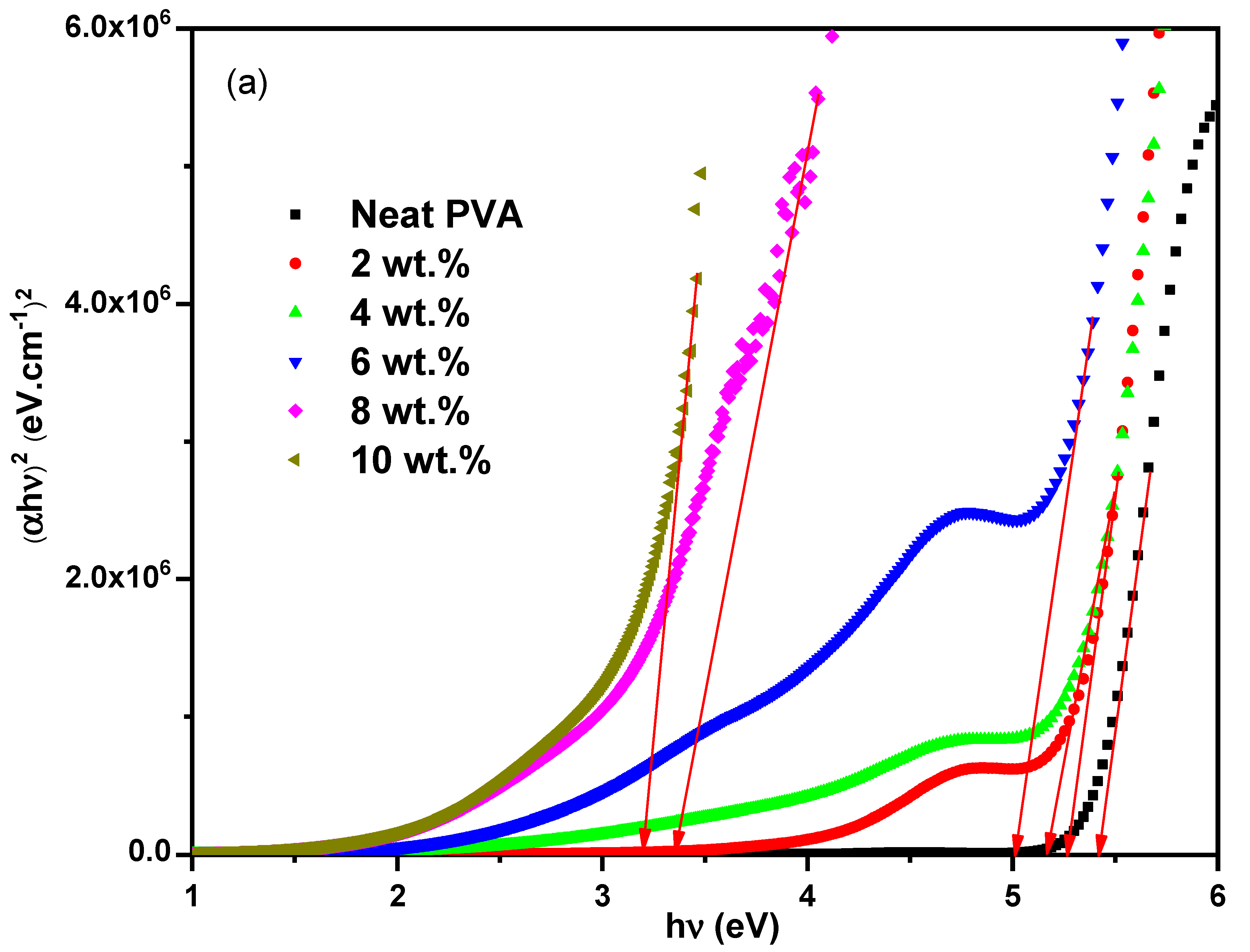
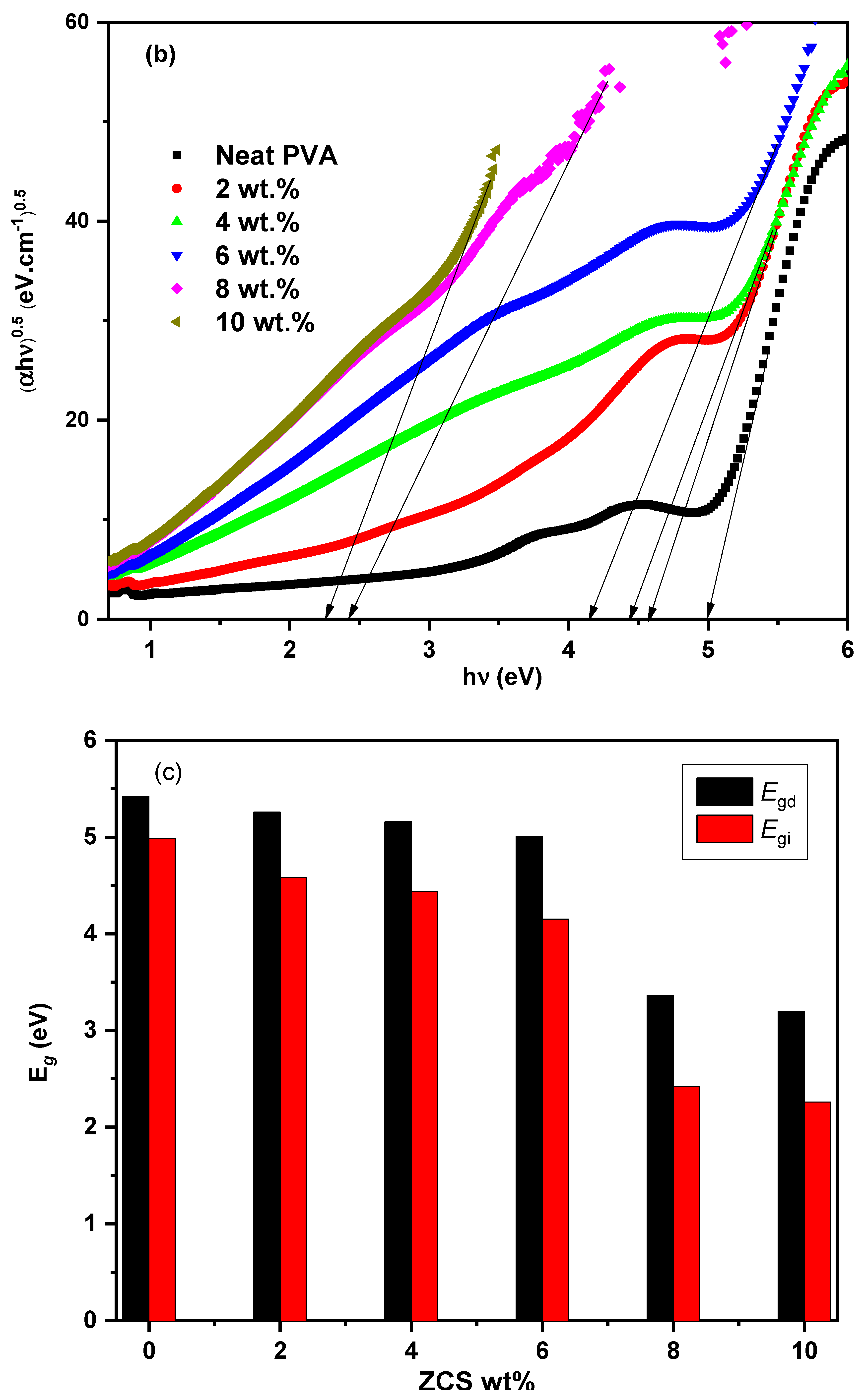

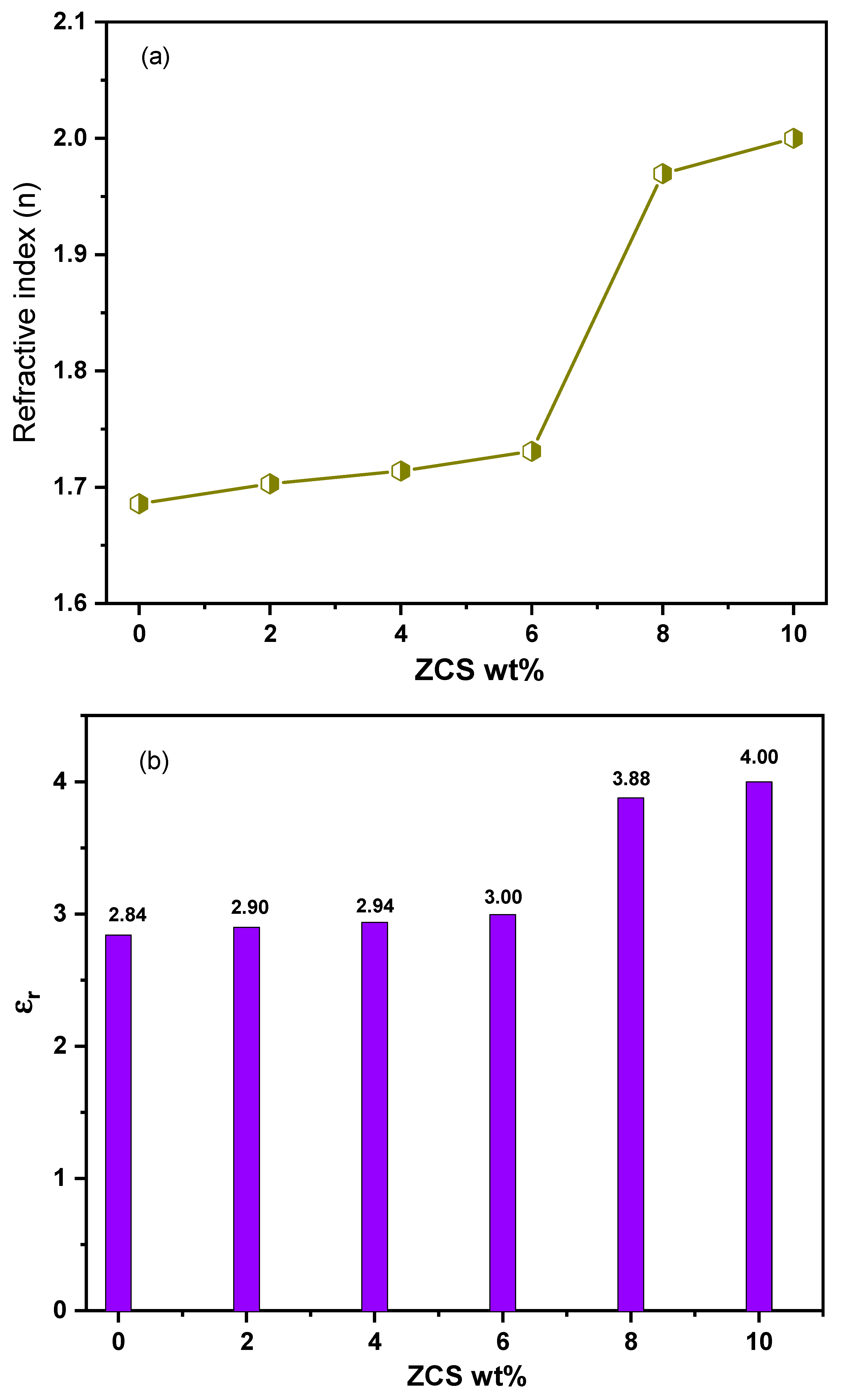


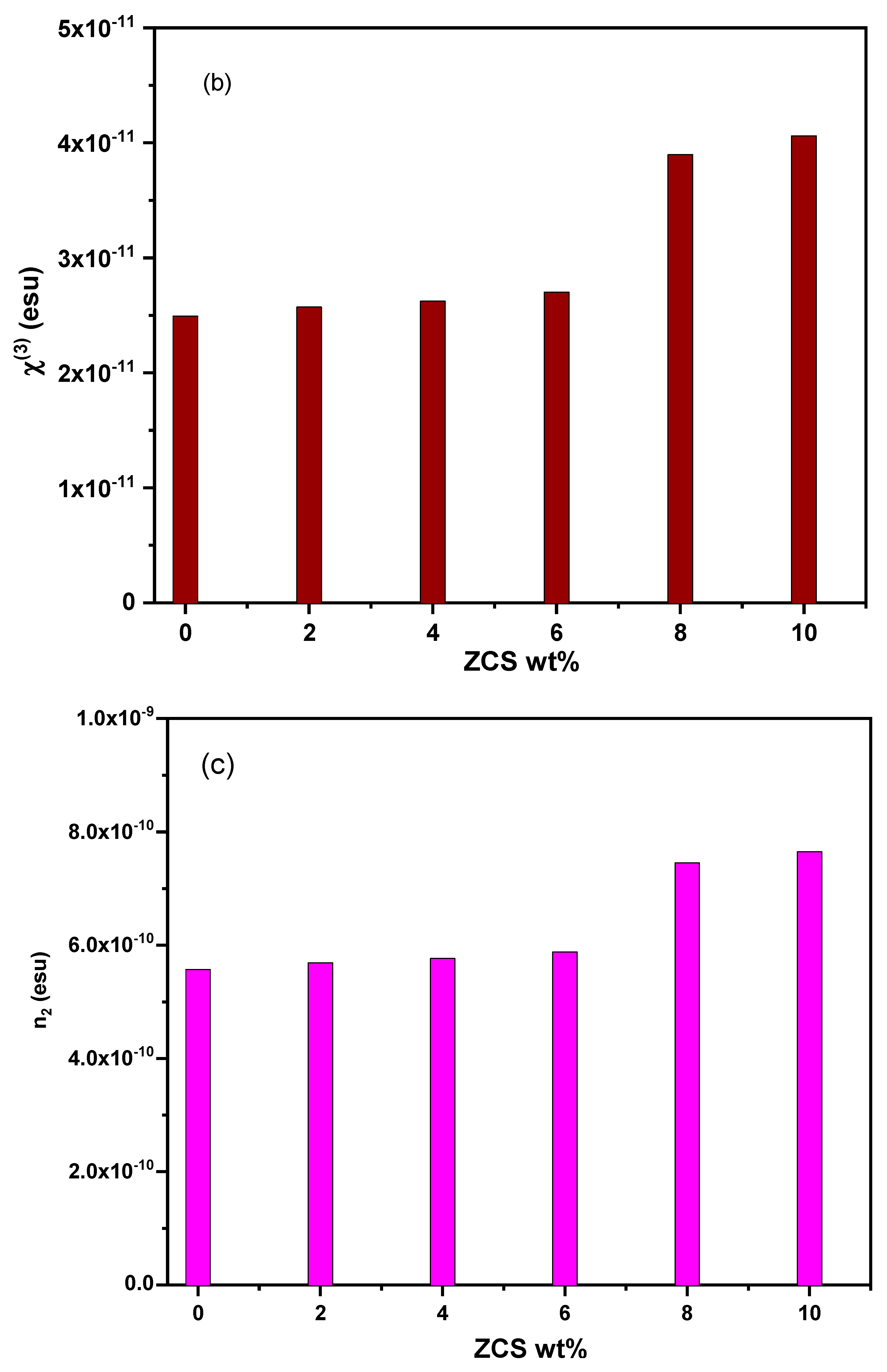
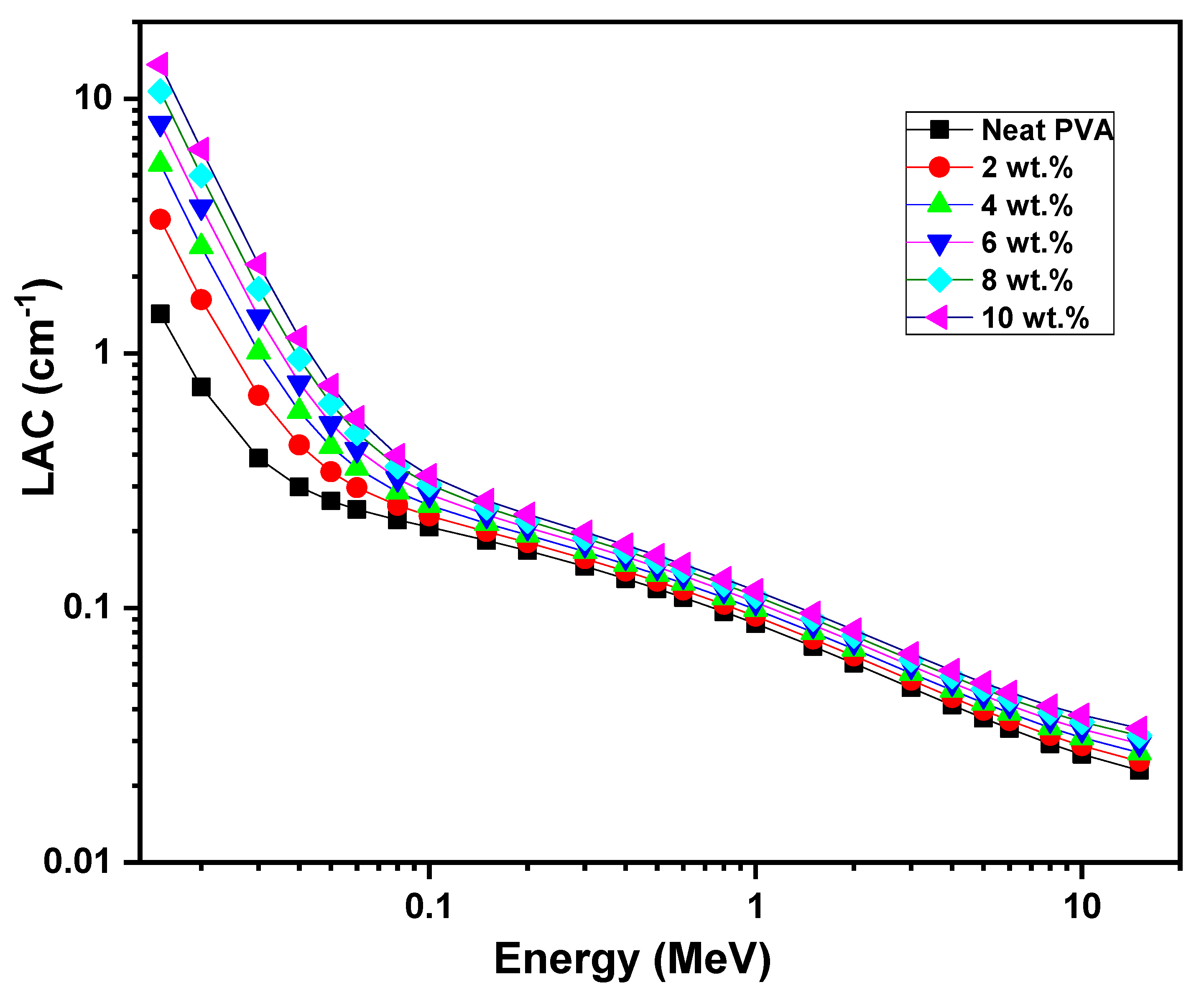

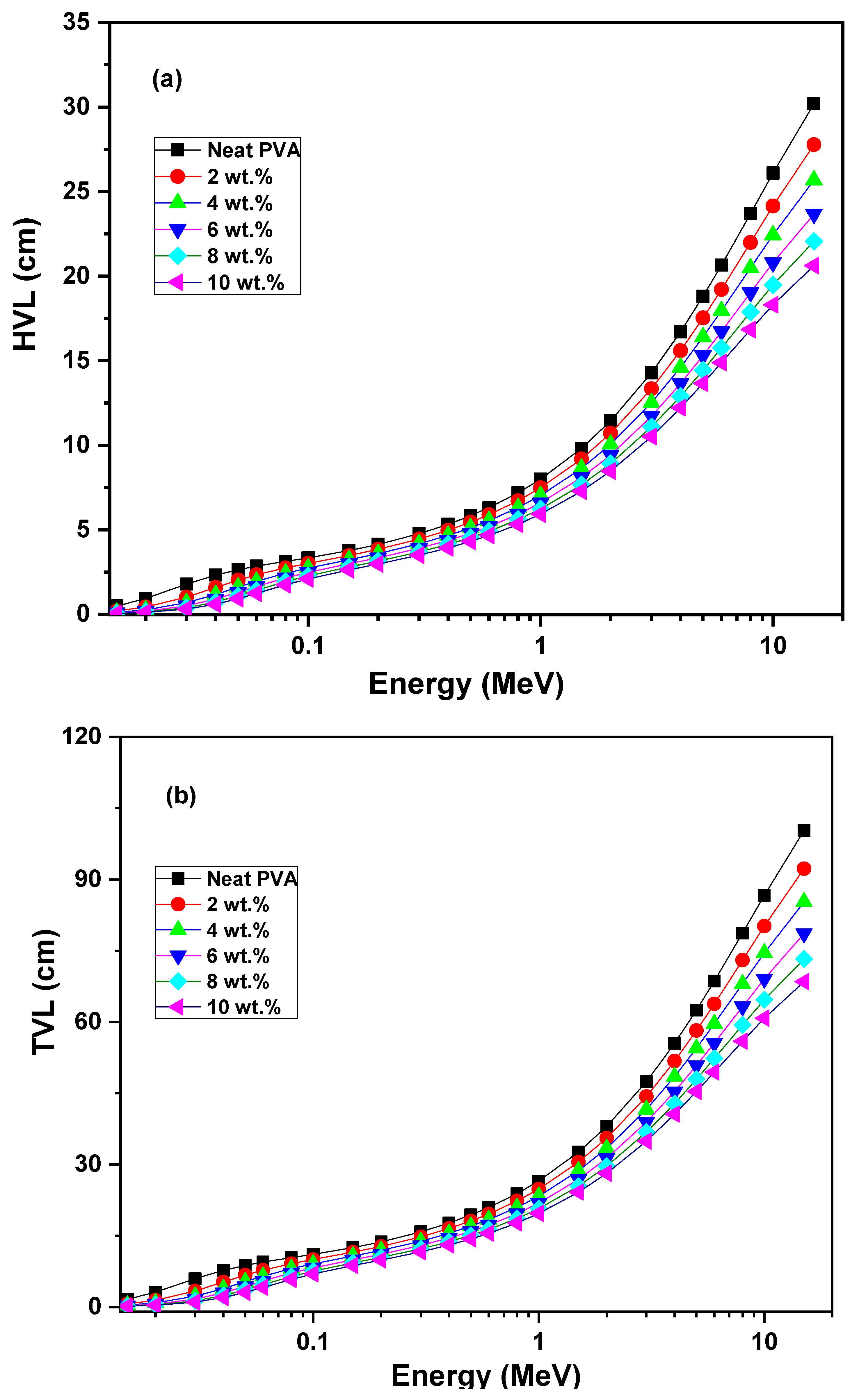

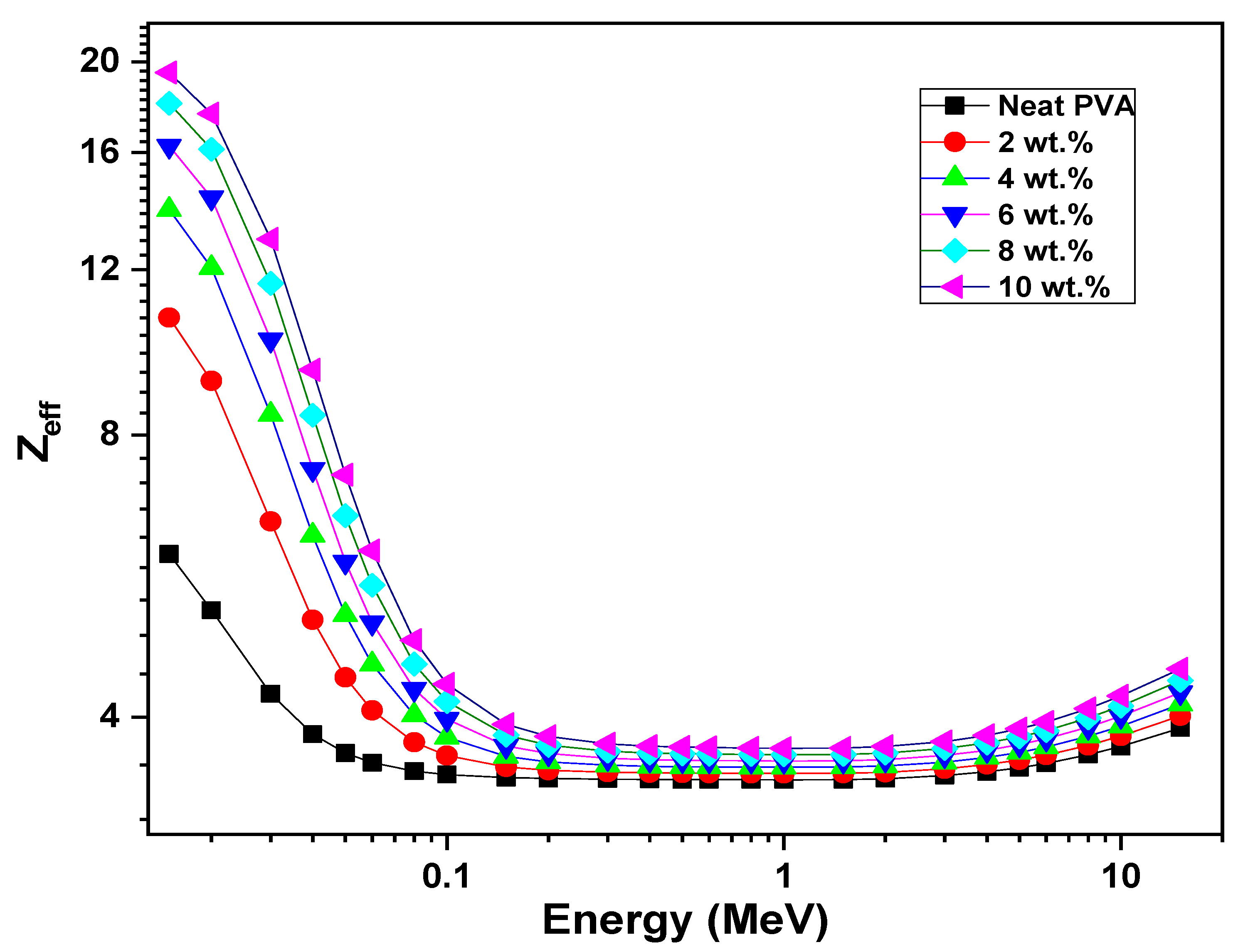
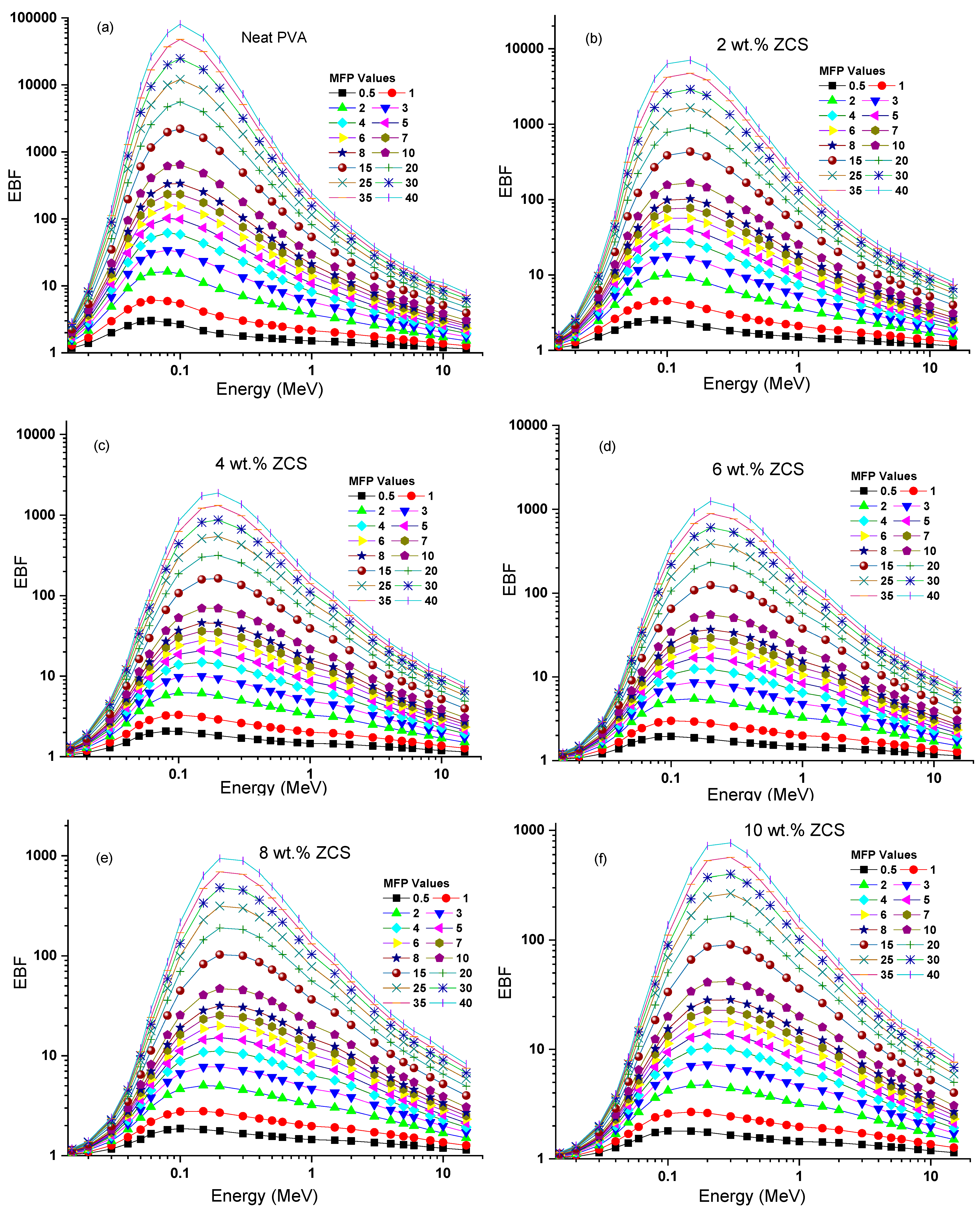
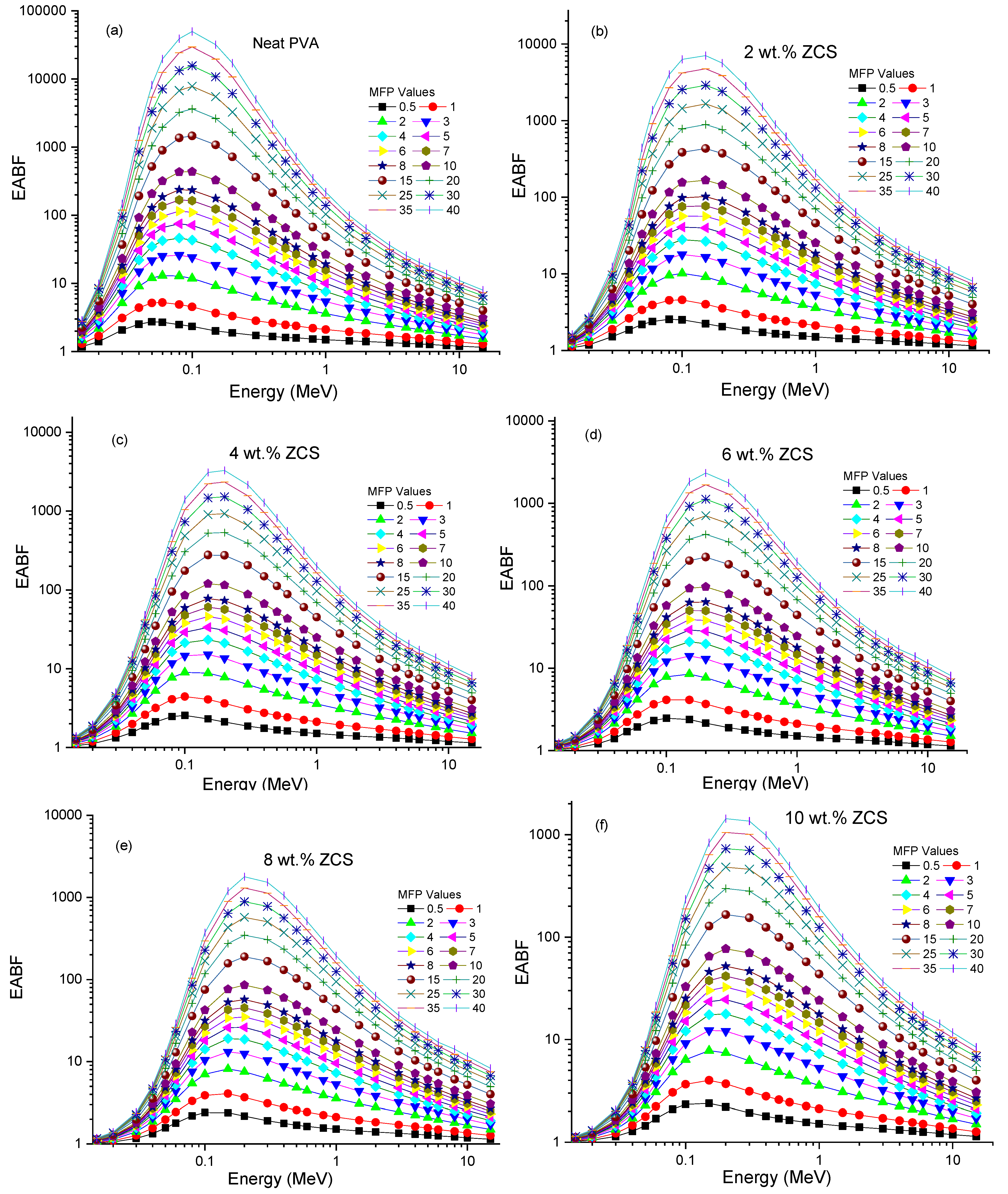
Disclaimer/Publisher’s Note: The statements, opinions and data contained in all publications are solely those of the individual author(s) and contributor(s) and not of MDPI and/or the editor(s). MDPI and/or the editor(s) disclaim responsibility for any injury to people or property resulting from any ideas, methods, instructions or products referred to in the content. |
© 2025 by the authors. Licensee MDPI, Basel, Switzerland. This article is an open access article distributed under the terms and conditions of the Creative Commons Attribution (CC BY) license (https://creativecommons.org/licenses/by/4.0/).
Share and Cite
Alharthi, S.S.; Badawi, A. Polymeric Nanocomposites of Polyvinyl Alcohol Embedded with ZnO/CuO/Single-Walled Carbon Nanotubes: Optical and Radiation Shielding Investigations. Polymers 2025, 17, 818. https://doi.org/10.3390/polym17060818
Alharthi SS, Badawi A. Polymeric Nanocomposites of Polyvinyl Alcohol Embedded with ZnO/CuO/Single-Walled Carbon Nanotubes: Optical and Radiation Shielding Investigations. Polymers. 2025; 17(6):818. https://doi.org/10.3390/polym17060818
Chicago/Turabian StyleAlharthi, Sami S., and Ali Badawi. 2025. "Polymeric Nanocomposites of Polyvinyl Alcohol Embedded with ZnO/CuO/Single-Walled Carbon Nanotubes: Optical and Radiation Shielding Investigations" Polymers 17, no. 6: 818. https://doi.org/10.3390/polym17060818
APA StyleAlharthi, S. S., & Badawi, A. (2025). Polymeric Nanocomposites of Polyvinyl Alcohol Embedded with ZnO/CuO/Single-Walled Carbon Nanotubes: Optical and Radiation Shielding Investigations. Polymers, 17(6), 818. https://doi.org/10.3390/polym17060818






